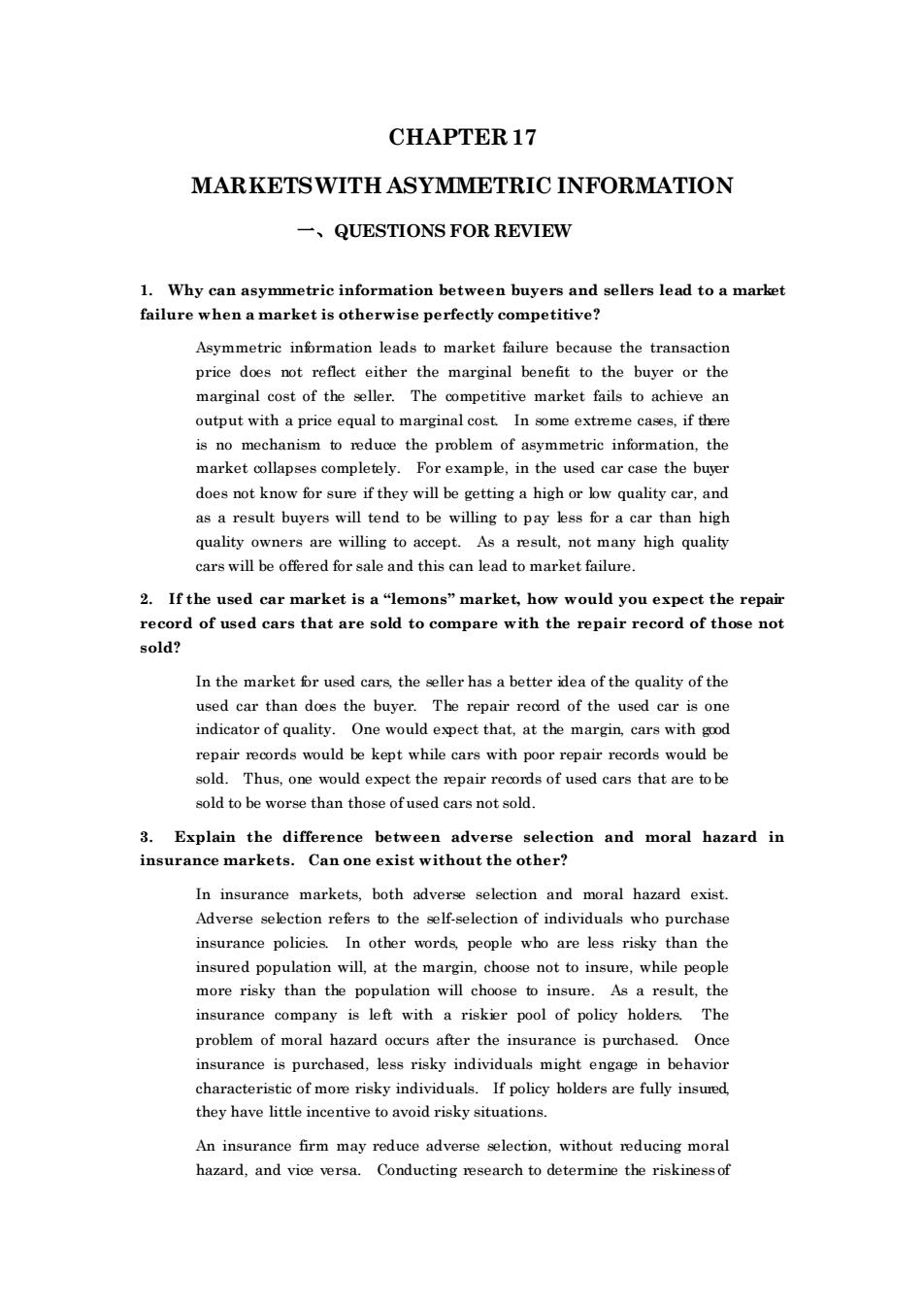正在加载图片...

CHAPTER17 MARKETSWITH ASYMMETRIC INFORMATION 一、QUESTIONS FOR REVIEW 1.Why can asymmetric information between buyers and sellers lead to a market failure when a market is otherwise perfectly competitive? Asvmmetric infrmation leads to market failure because the transaction price does not reflect eithr the marginal benefit to the buyer or the marginal cost of the elle The competitive market fails to achieve an output with a price equal to marginal cost.In some extreme cases,if there is no mechanism to reduce the problem of asymmetric information,the market oollapses completely.For example,in the used car case the buyer does not know for sure if they will be ge tting a high or w quality car, as a result buyers will tend to be willing to pay s s for a car than high quality owners are willing to accept.As a result,not many high quality cars will be offered for sale and this can lead to market failure. 2.If the used car market is a"lemons"market,how would you expect the repair record of used cars that are sold to compare with the repair record of those not sold? In the market for used car the seller has a better idea of the quality of the sed car than sthe buyer The repa rd of the ca 80n indicator of quality.One would expect that,at the margin,cars with good repair records would be kept while cars with poor repair records would be sold.Thus,one would expect the repair records of used cars that are to be sold to be worse than those ofused cars not sold. en adverse selection and moral hazard in kets Can one exist without the other? In insurance markets,both advers selection and moral hazard exist Adverse sek ction refers to the self-selection of individuals who purchase insurance policies.In other words,people who are less risky than the insured population will,at the margin,choose not to insure.while people more risky than the population will choose to insure.As a result,the insurance is left with a riskier pool of policy holders The problem of moral haza rd occurs after the insurance is purchased Onc insurance is purchased,less risky individuals might engage in behavior characteristic of more risky individuals.If policy bolders are fully insured they have little incentive to avoid risky situations. An insurance firm may reduce adverse selection.without reducing moral hazard,and vice versa.Conducting research to determine the riskinessof CHAPTER 17 MARKETS WITH ASYMMETRIC INFORMATION 一、QUESTIONS FOR REVIEW 1. Why can asymmetric information between buyers and sellers lead to a market failure when a market is otherwise perfectly competitive? Asymmetric information leads to market failure because the transaction price does not reflect either the marginal benefit to the buyer or the marginal cost of the seller. The competitive market fails to achieve an output with a price equal to marginal cost. In some extreme cases, if there is no mechanism to reduce the problem of asymmetric information, the market collapses completely. For example, in the used car case the buyer does not know for sure if they will be getting a high or low quality car, and as a result buyers will tend to be willing to pay less for a car than high quality owners are willing to accept. As a result, not many high quality cars will be offered for sale and this can lead to market failure. 2. If the used car market is a “lemons” market, how would you expect the repair record of used cars that are sold to compare with the repair record of those not sold? In the market for used cars, the seller has a better idea of the quality of the used car than does the buyer. The repair record of the used car is one indicator of quality. One would expect that, at the margin, cars with good repair records would be kept while cars with poor repair records would be sold. Thus, one would expect the repair records of used cars that are to be sold to be worse than those of used cars not sold. 3. Explain the difference between adverse selection and moral hazard in insurance markets. Can one exist without the other? In insurance markets, both adverse selection and moral hazard exist. Adverse selection refers to the self-selection of individuals who purchase insurance policies. In other words, people who are less risky than the insured population will, at the margin, choose not to insure, while people more risky than the population will choose to insure. As a result, the insurance company is left with a riskier pool of policy holders. The problem of moral hazard occurs after the insurance is purchased. Once insurance is purchased, less risky individuals might engage in behavior characteristic of more risky individuals. If policy holders are fully insured, they have little incentive to avoid risky situations. An insurance firm may reduce adverse selection, without reducing moral hazard, and vice versa. Conducting research to determine the riskiness of